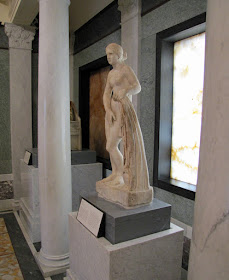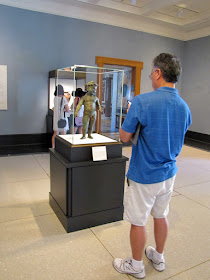This is the view upon first entering the Getty Villa.
Bronze Roman theatrical statue of a comic actor,
Another bronze Roman theatrical statue of a comic in full costume.
Sarcophagus with scenes of Bacchus. 210-220 AD, Rome. The inscription on the lid: "To the soul of the deceased. For Maconiana Severiana, the sweetest daughter, Marcus Sempronius Faustinianus, vir clarissimus [holding a senatorial rank], and Praecilia Severiana, clarissima femina [from a senatorial family], her parents [had this made]. The sarcophagus is small, so she must have died before adulthood.
Wine cup with crouching Satyr. About 480 BC, Greek made in Athens. Terracota. Artist was Makron the painter. More of his work survives than any other vase painter from the fifth century BC.
Comedy masks. Greek, 300-200 BC. Terracotta and pigment.
Roundel with a Comic Mask. 300 BC, Greek from south Italy. Bronze.
They had a number of displays showing Greek, Roman, and Etruscan timelines and how they related to each other.
Sarcophagus with scenes from the Life of Achilles. 180-220 AD, Attica, Greece. Faces were left unfinished so that purchaser of coffin could have their faces carved.
The Landsdowne Herakles. 125 AD, Roman. Marble. This was one of J. Paul Getty's most prized possessions - it inspired him to build the museum in the style of an ancient Roman villa. Shortly after its discovery in 1790, the statue was reworked by a Rome restorer. It was stripped of the restorations in the 1970s, but the additions reintegrated in the 1990s.
Zeus. About 100 BC, Greek. Marble. This statue was submerged in the sea for a considerable amount of time. The well-preserved portion was buried in sand.
Muse. 200 AD, Roman. Marble, pigment, gold. Particles of gold leaf remain in her hair, which was originally fully gilded.
Venus. 175-200 AD. Roman. Marble and pigment.
The Hall of Colored Marbles emulates luxurious rooms that served as status symbols in the Roman Imperial period. Romans used a wide variety of marbles imported from distant lands. The patterns in this hall were inspired by those found in Pompeii and Herculaneum.
Bull statue. 100 BC - 79 AD. Roman. Silver and gold.
Fertility goddess statuette. 600-575 BC. Greek, made in Boiotia. Terracotta.
Mixing vessel. 390-350 BC. Athens, Greece. Terracotta.
Vessel with Leda and the Swan. 330 BC. Greek, made in Apulia, South Italy. Terracotta.
Mixing Vessel with Apollo and Artemis. 415-400 BC. Greek, made in Lucania, South Italy. Terracotta.
Statuette of Venus. 100-300 AD. Roman. Silver and gold.
Young boy. 1-50 AD. Roman. Bronze, silver and copper. Marks on the shoulder blades suggest that wings were once attached.
Statuette of Poseidon. 120-100 BC. Greek, made in eastern Mediterranean. Bronze.
































No comments:
Post a Comment